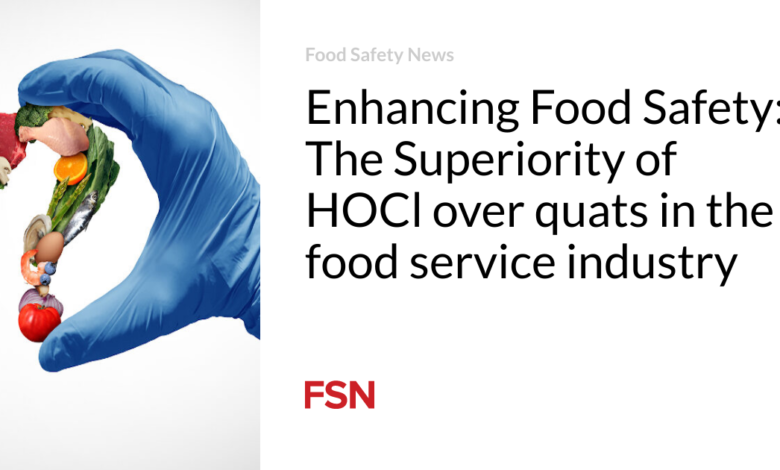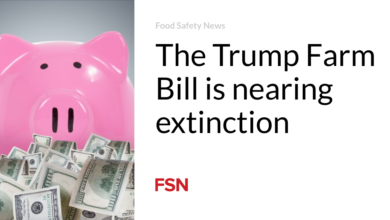Enhancing Food Safety: The Superiority of HOCl over quats in the food service industry

— OPINION —
By Francine L. Shaw
The usage of Hypochlorous acid (HOCl) in the food service industry has gained significant attention due to its effectiveness in combating various pathogens and reducing the risk of foodborne illnesses. In comparison to quaternary ammonium compounds (quats), HOCl offers several advantages that make it a preferred choice for maintaining food safety standards.
Norovirus outbreaks, commonly experienced on cruise ships and in foodservice settings, have highlighted the importance of robust sanitization methods. HOCl has proven effective in eradicating viruses and pathogens, including Norovirus, Hepatitis A, Salmonella, and Listeria. Its successful implementation on Norwegian Cruise Lines during the pandemic showcased its ability to mitigate outbreaks. According to the CDC’s website, NCL is one of two US based cruise lines that have not had a norovirus outbreak since their implementation of hypochlorous acid.
A NoroStatstudy highlights the increasing danger of the highly contagious virus, recording 519 outbreaks from August 1, 2023, to January 15, 2024 – marking a significant uptick from the previous year. The necessity for proactive interventions to contain its transmission is apparent.
Hepatitis A cases are also on the rise in foodservice settings, underscoring the necessity for preventive strategies. As of February 2, 2024, there have been 44,779 confirmed cases of the virus, leading to hospitalization in approximately 61% of cases (around 27,342 hospitalizations). Tragically, 421 individuals have lost their lives. Since the initial outbreak in 2016, 37 states across the country have reported cases to the CDC. Of course, all of this is preventable with a vaccine. The infectious nature of Hepatitis A amplifies the importance of stringent hygiene practices. HOCl’s capacity to combat a wide range of pathogens, along with its safety profile, makes it a reliable choice for sanitization in foodservice establishments.
The usage of hypochlorous acid (HOCl) in the food service industry has gained significant attention due to its effectiveness in combating various pathogens and reducing the risk of foodborne illnesses. In comparison to quaternary ammonium compounds (quats), HOCl offers several advantages that make it a preferred choice for maintaining food safety standards, including that it’s more potent than bleach and effective at killing a variety of pathogens, is safe to use on and around foods, is eco-friendly, and is compliant with CDC, FDA, and EPA regulations.
Salmonella outbreaks have affected hundreds in recent months, emphasizing the critical role of effective sanitization protocols. HOCl has emerged as a promising sanitizer due to its efficacy in reducing pathogens like E. coli, Salmonella, and Listeria. Its ability to target pathogens on various surfaces and produce items enhances food safety measures.
Produce requiring a “kill step” highlights the critical need for ensuring food safety in the supply chain. Unlike other food items that undergo cooking or pasteurization processes, fresh produce lacks a definitive step to eliminate pathogens. By implementing a kill step for produce, such as washing with sanitizing agents like HOCl, the potential risks associated with microbial contamination can be significantly reduced. This proactive approach aims to eradicate harmful pathogens like E. coli, Salmonella, and Listeria present on fruits and vegetables, minimizing the likelihood of foodborne illnesses. Incorporating a kill step for produce not only enhances consumer safety but also prolongs the shelf-life of fresh items, ensuring that they are safe for consumption and meet stringent food safety standards.
Applying HOCl as a no-rinse sanitizer for produce, meat, poultry, and seafood in restaurants prolongs the shelf-life of food items by effectively reducing bacteria and pathogens present on the surfaces. Its versatility and efficiency make it a valuable asset in maintaining high standards of food safety.
In comparison to quats, which have been widely used in the food service industry, HOCl offers an improved safety profile and effectiveness against a broader spectrum of pathogens. The growing concerns regarding quat exposure and potential risks associated with their usage have spurred a shift towards safer and more efficient sanitization methods like HOCl.
Food irradiation is a process that involves using ionizing radiation to treat food. This innovative method helps enhance food safety and extend its shelf life by reducing the presence of microorganisms and insects. Comparable to pasteurization for milk and canning for fruits and vegetables, irradiation plays a vital role in ensuring the safety of food for consumption. The Food and Drug Administration (FDA) oversees the regulation of radiation sources used in food irradiation. Approval for the use of radiation on food is granted by the FDA only when it is determined to be safe.
The implementation of advanced technologies like IoT monitoring, supply chain traceability, and AI risk prediction further enhances the efficacy of HOCl in ensuring food safety. By embracing innovative tools and following strict protocols, food establishments can navigate challenges and prioritize consumer trust by offering safer and more resilient services.
In conclusion, the benefits of using HOCl in the food service industry are clear. Its ability to combat a wide range of pathogens, reduce the risk of foodborne illnesses, and enhance food safety practices positions it as a superior choice for sanitization. By leveraging the advantages of HOCl and integrating technological innovations, stakeholders can elevate their food safety standards and foster a healthier environment for consumers.

About the author: Francine L. Shaw is a food safety specialist, podcaster, founder of Savvy Food Safety, co-founder of My Trusted Source, author of “Who Watches the Kitchen?”, and a successful entrepreneur, and speaker who spent 30+ years working in the foodservice industry. Her career has included performing services (operating partner, corporate/private trainer, health inspector, third party inspector, adjunct professor) in various sectors of the foodservice industry. She has written hundreds of articles for national trade magazines and appeared on the BBC World Series Radio, and iHeart Radio as a food safety expert.


